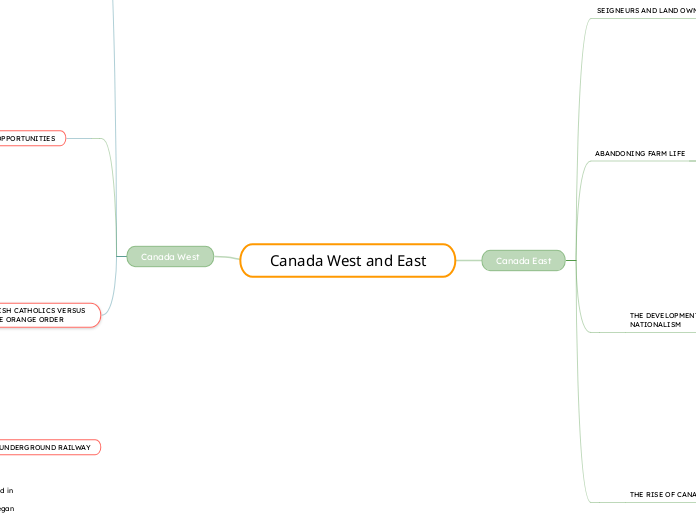Canada West and East
Canada East
SEIGNEURS AND LAND OWNERSHIP
Wealthy landowners, known as seigneurs, rented land to Canadien farmers. The Papineaus owned 180,000 acres on the Ottawa River, named Papineauville and Quebec. Louis-Joseph Papineau was a key politician.
Wealthy landowners, known as seigneurs, rented land to Canadien farmers. The Papineaus owned 180,000 acres on the Ottawa River, named Papineauville and Quebec. Louis-Joseph Papineau was a key politician.
ABANDONING FARM LIFE
In the mid-1800s, Canadiens in Canada East faced financial struggles due to the small farms they farmed, which became smaller over generations. To support their families, they turned to the lumber industry, where business owners hired desperate men at low wages. Many couldn't repay these debts, highlighting the challenges faced by many farmers in the region.
Hundreds of thousands of Canadiens were forced to leave their farms and move to cities for work, increasing the population from 5% in 1800 to 20% by 1867. Many left Canada East to find work in the United States.
THE DEVELOPMENT OF FRENCH
NATIONALISM
In 1840, the Act of Union united Upper and Lower Canada into the Province of Canada, with English politicians dominating the government to assimilate French people and remove the French language.
Canadiens fought against the assimilation of them into English culture, promoting French nationalism to create a national identity and protect their language, religion, and culture. Governors like Lord Metcalfe and Lord Elgin supported Canadiens keeping their culture, while others, like the Papineaus, criticized the British governor for attempting to destroy their culture. Various groups of Canadien leaders promoted Canadien nationalism, including the Papineaus.
Catholic bishops and priests in British North America promoted the French language's importance and gained political influence, encouraging Canadiens to become leaders of Catholicism in the Americas. This led to the promotion of Canadien nationalism.
THE RISE OF CANADIEN ARTISTS
In the mid-1800s, a French-speaking middle class in Canada East embraced Canadien literature and arts, with writers like Garneau and Gaspé popularizing Canadien history and stories. They created stories about Canadien heroes like Joseph Montferrand, a lumberjack known for defending fellow Canadiens against British bullies.
Subtopic
Canada West
Railway System
Before the 1850s, ships transported crops and timber to Europe and the US, benefiting those near ports.
Canada West and East Canada West can benefit from a connected railway system for efficient transportation
A well-developed railway system is crucial for economic growth and trade between Canada West and East Canada West
The railway system can promote tourism by providing convenient and scenic transportation options
The railway system can improve accessibility and connectivity between different regions in Canada West and East Canada West
OPPORTUNITIES
Railway development led to towns like Toronto and Boston becoming hubs of commerce for remote settlements. Fertile land was farmed north of Lake Ontario and Lake Erie. As railways expanded, towns expanded to provide services, repair farming equipment, and support local industries.
For example, farmers sold
their grain to mills, which converted it into flour to be sold thousands
of kilometres away. Woollen mills turned sheep’s wool into fabric for the
clothing industry. This development encouraged other local farmers to
expand their farming activities to include both sheep and grain.
The railways in Canada West created economic growth, attracting immigrants like Thornton Blackburn and his family. After escaping slavery in the US, they arrived in Canada West after 1833's outlawing of slavery. They earned and saved enough money to start their own business, starting the first cab service in Toronto.
IRISH CATHOLICS VERSUS
THE ORANGE ORDER
Between the 1840s and 1860s, Canada West's population tripled to nearly 1.5 million, with Irish immigrants becoming the largest ethnic group. However, many struggled to afford land, so they found employment in railroad construction and local industries. They had to compete with Canadians and other immigrants for jobs, causing social tensions.
Tensions between Irish Catholics and Protestants in Canada West led to the formation of Protestant and Catholic societies, including the Orange Order, which held secret meetings and trained to defend their communities.
UNDERGROUND RAILWAY
Slavery was abolished in 1833 in British North America, but in the southern US, the Underground Railroad was established to help enslaved Black people escape. The Fugitive Slave Act in 1850 allowed slave owners to recapture escapees, causing more people to flee to British North America.
Black settlements in southern Canada West formed, with Mary Ann Shadd starting schools and establishing abolitionist newspapers in the 1850s, educating the public about slavery and the Underground Railroad.
FARMING
The railroad and increased agricultural demand in Canada West led to increased farming, encouraging other industries. Entrepreneurs began manufacturing farm machinery, leading to 31 factories by 1861. Farmers borrowed money to buy new technology, and new railroads made transportation easier. The Massey Company's factory in Toronto employed 700 people.
The Mississauga community in Canada West faced challenges from new immigrants and land development companies who sought fertile land. The government refused to acknowledge their ownership and auctioned off the land to settlers. Ojibwe leaders Nahnebahwequay and David Sawyer helped local bands start farms, which attracted immigrant farmers. The Canadian government forced bands to sign away their territories, and some First Nations tried to buy their land back. Catherine Sutton and others protested against this unfair treatment, as did many in Britain.
